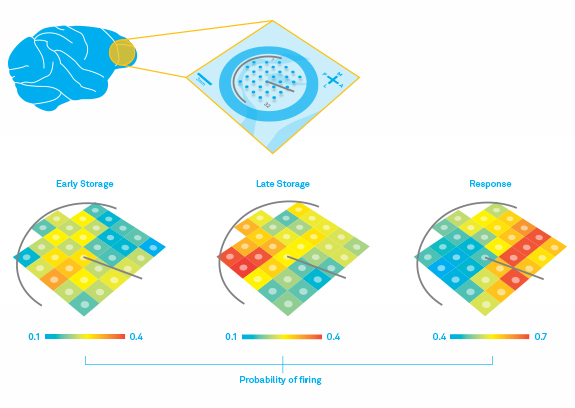
The prefrontal cortex of the brain is marked in the top, left illustration, with an accompanying pullout depicting an array of electrodes used to record neuronal activity there. The three grids, which depict the activity recorded by each electrode during different stages of working memory, show the probability of neurons in the indicated areas firing. The bars show the likelihood of firing at each stage. There is a remarkably different firing pattern during the late storage stage compared with the early storage stage, and also the late storage stage compared with the response stage. Adapted from D. Markowitz et al, Proceeding of the National Academy of Sciences 112, 11084-11089 (2015).
The secrets to the production of our thoughts, memories and emotions appear to be hidden in the populations of neurons that make up our brains. "Something happens within those sets of nerve cells so that mind and percepts emerge," says Gerald D. Fischbach, chief scientist and fellow of the Simons Foundation. "We want to know how."
Deciphering how memories, emotions and other aspects of cognition emerge requires the best and brightest researchers in neuroscience and, importantly, work and dialogue between them. That is why the Simons Collaboration on the Global Brain (SCGB) has brought together 70 investigators who are using both theory and experiments to understand the neural coding and dynamics that give rise to decisionmaking, thoughts, memories and so much more.
Since the 1950s, scientists have studied individual neurons and made great progress in understanding the mechanics of how a neuron can use electrochemical signals to encode and transmit information. In the SCGB, scientists are now pushing that research further, recording and tracking the signals of hundreds or even thousands of neurons, and searching for patterns in the signals those cells send.
Sifting through the resulting signals is a complex computational task. A single neuron can fire 1,000 times a second — every second — and a single neuron can connect to up to 1,000 other neurons, meaning billions of bits of information move through the brain every second. Analyzing all of this activity requires collaboration: Experimentalists work closely with theorists to develop rigorous statistical analyses of the data, and theorists can use the data to create new models of neural circuits and networks that inform future experiments. SCGB findings published in 2015 illustrate the intersection of experiment and theory.
SCGB Investigator Michale Fee of the Massachusetts Institute of Technology and his team conducted an elegant series of experiments that explain how young zebra finches learn new songs. This work confirmed many of the predictions in SCGB Investigator Ila Fiete's theory on the same topic. What Fiete previously proposed and Fee confirmed was that neurons in the birds' high vocal center fire in limited bursts, which encode information for a sequence of a few song notes. The brain duplicates the sequence, so that there are two sequences, which then evolve independently as the bird learns more notes for the song. The two sequences are then duplicated and the resulting sequences evolve separately, then duplicate and evolve, until the complete song is encoded in the cells.
Neurons can also encode where an animal is in its environment. These neurons, called grid cells, are good at getting us where we need to go. But, like the GPS navigation systems in our phones and cars, the neurons can sometimes make mistakes and lead us off course. In mice, this happens when grid cells start firing when the animal is far from the space where the cells usually fire. SCGB Investigators Surya Ganguli and Lisa Giocomo of Stanford University, along with Kiah Hardcastle, Giocomo's graduate student, found that grid cells can accumulate errors surprisingly quickly, within two minutes, not the 30 to 40 minutes the team had suspected. The errors arise if the mouse turns too much or too little, or if it miscalculates its speed, and small mistakes add up over time. But, the team found, a mouse's grid cells can correct miscalculations after the animal bumps into a wall or some other boundary. These observations support the theory that grid cells use speed and direction to calculate the animal's location and are a first step toward understanding how external environmental cues shape the brain's spatial representations of the world.
Theory and experiment, however, are interactive and can evolve as more information becomes available. SCGB Investigator Bijan Pesaran of New York University and his colleagues found that understanding working memory — the immediate and temporary processing of new information — is more complex than scientists had thought. Theory suggested that a single centralized network of neurons, which all work the same way, support working memory. But Pesaran and his team showed that a monkey's working memory is supported by three specialized yet anatomically distinct networks of neurons that work together to encode information. The results, the researchers write, reveal specific circuit-level neural populations that may hold clues as to how working memory functions, and how it can go awry.
Collaboration is critical to making these kinds of advances. So is an infusion of new minds into neuroscience. In 2015, the SCGB launched a prestigious fellowship program to invite up to 10 promising early career scientists to join the collaboration each year. "The goal is to introduce these students to the mysteries of the brain and have them apply their knowledge of physics, math and other fields to solving the great questions of how our minds work," Fischbach says. "This is the great frontier of the field."



